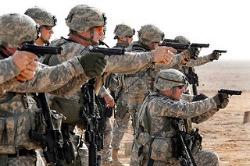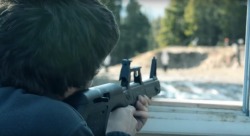 As the old adage goes, there really is no substitute for experience. This counts double time for shooting experience only gained by “popping lots of caps” as the Mil-Gens like to say. Of course, they borrowed that ole saying from us baby boomer boomers. The point is though that to gain valuable shooting experience, competency, and confidence, you have to shoot. That translates into shooting a lot, shooting correctly, and becoming skillful at it.
As the old adage goes, there really is no substitute for experience. This counts double time for shooting experience only gained by “popping lots of caps” as the Mil-Gens like to say. Of course, they borrowed that ole saying from us baby boomer boomers. The point is though that to gain valuable shooting experience, competency, and confidence, you have to shoot. That translates into shooting a lot, shooting correctly, and becoming skillful at it.
I fear and hope I am wrong that among many in the ranks of self-proclaimed preppers and survivalists, there is profuse, unconscious incompetence. That is stated not to degrade any of us, but just to focus on what could be a point of fact. We love our guns, love to buy them, covet them, clean them, disassemble them, accessorize them, and stock up on all the gun related goodies just in waiting for the ultimate SHTF. But, can we shoot them? Can we shoot them with trained skills, and experienced proficiency?
I don’t mean either just plinking on the weekends at tin cans or paper targets of reeking zombies or threatening thugs. I mean really serious, professional level skills training type shooting. That implies taking formal classes in learning all of the shooting related skills with all the weapons you have or intend to use.
The Point Brought Home
 While attending a recent shooting and training seminar put on by a couple of instructors from Glock, one of the guys made a profound statement that has really stuck with me. He was trying to get all the shooters to concentrate on the target profile, manage the trigger, and recover from the recoil which was really negligible with the Glock 19s we were using. He was training us to pinpoint the target and stay on it for every shot.
While attending a recent shooting and training seminar put on by a couple of instructors from Glock, one of the guys made a profound statement that has really stuck with me. He was trying to get all the shooters to concentrate on the target profile, manage the trigger, and recover from the recoil which was really negligible with the Glock 19s we were using. He was training us to pinpoint the target and stay on it for every shot.
The firing was a quick string of only five rounds each, trying to put all five in the kill zones of the human outline targets. The range was ten yards. The goal was to focus on hits, again and again. It seemed redundant, but one could see the utility of it. One participant in the class did not quite get it, so he asked about the point of it all.
The instructor replied, “In a gun fight, you can’t miss fast enough to win.” Mull that one over in your mind for a moment. That just about says it all and sums up the whole reason to practice your shooting, keep practicing and shooting until all those rounds hit the zone.
Range Research
Pulling the trigger, repeatedly, is just shooting. If it is always casual, or worse yet, just haphazard, then you’re probably wasting your time and ammo. I’m not saying informal plinking is not useful or at least fun, but it is not entirely always honing the skills necessary for self- preservation when the time comes.
 This demands the proper initial orientation training with firearms. If you own/shoot handguns, rifles, and shotguns, then you will eventually need training with all three. Formal training can take many forms. Course names vary but usually include a menu of titles such as Basic Pistol, Defensive Pistol, Advanced Defensive Pistol, Defensive Shotgun I & II, Concealed Carry, Basic and Advanced AR-15 courses, and simulator courses like Lethal Force and such.
This demands the proper initial orientation training with firearms. If you own/shoot handguns, rifles, and shotguns, then you will eventually need training with all three. Formal training can take many forms. Course names vary but usually include a menu of titles such as Basic Pistol, Defensive Pistol, Advanced Defensive Pistol, Defensive Shotgun I & II, Concealed Carry, Basic and Advanced AR-15 courses, and simulator courses like Lethal Force and such.
If, by chance, you think all this too complicated or involved or expensive, then let me reinforce the issue. The number one problem with inexperienced people buying guns is that they assume they can figure out how to use them, not unlike a chainsaw or welding machine (again, unconscious incompetence). It’s a recipe for disaster or at the very least, failure.
More often than not, newbie gun buyers never even shoot them at all. They go into a drawer or closet in the original box, often not even loaded, but sometimes at least that. Then when they are confronted, invaded or threatened requiring defensive force, they have no clue. They usually end up having their own gun turned on themselves with fatal consequences.
Your desire and pursuit of survival preparation does not make you a competent firearms user. You need professional training at a training range staffed by highly qualified instructors. But, how do you find one? How do you make sure they are good at what they do?
Related: Precision AR – 15s
Simple, first just ask around. When you buy a gun, ammo, or any gun accessories ask the store personnel for range recommendations. Sometimes there will be business cards, flyers, or handout sheets available in the store. Maybe they have a bulletin board for public notices. Some advanced gun shops have in-store or out back ranges that offer classes. Do your research and a good range will turn up.
Visit the range in person. Ask to talk to the manager or lead instructor. Pick up literature, course schedules and descriptions, as well as price sheets. Ask for a tour and ask lots of questions. Will they provide references? Do they have a Better Business Bureau rating? Do they belong to the local Chamber of Commerce, etc.? Do they offer what you need? Do they rent guns for training use and/or sell them? Do they do a custom gun fitting to you?
Regardless of how elementary their initial course offering may sound, sign up for it and take it. Begin to establish yourself at the range for future courses, or other shooting opportunities. They may allow course graduates use of the range on weekends or other times. In time take the advanced classes to attain more experience and skills. Add training on long guns, too. Eventually, your comfort level with proficient shooting will take form.
Become a Second Nature Shooter
In time, handling, maintaining and shooting all of your prepper-survival firearms will, should become second nature. Picking up your primary self-defense handgun will happen without so much as a second thought. That is the level of skill you want to attain.
The shooting practice must continue regularly. There are many other skills to acquire, too. That includes concealed carry if you exercise that option. Carry outside the waist should be practiced as well. When you get to the range again, practice drawing and shooting your weapon at 7-10 yards keeping the holes in the target kill zone.
Practice changing magazines in the middle of a shooting string. Stop in the middle of a magazine, drop the mag, clear the chamber, reload a new mag, crank the slide and shoot again. These are shooting sequences you will need to be able to perform with reliance. Speed in doing this is not the first issue, but successful completion of the task. Speed can and will come later.
![]() Begin the same exercises using your primary defense rifle(s). Shoot ranges of 25-50-100 yards. Use both open sights, then optical sights, electronics, holographic, whatever you choose. If you shoot the 5.56/.223 AR, 7.62×39 AK, or a .308 variant, shoot them all. Do the mag changes, too. This also includes any other rifle(s), bolt action, or hunting type rifles you may intend to deploy. You need practice and experience bringing all your guns to bear if needed.
Begin the same exercises using your primary defense rifle(s). Shoot ranges of 25-50-100 yards. Use both open sights, then optical sights, electronics, holographic, whatever you choose. If you shoot the 5.56/.223 AR, 7.62×39 AK, or a .308 variant, shoot them all. Do the mag changes, too. This also includes any other rifle(s), bolt action, or hunting type rifles you may intend to deploy. You need practice and experience bringing all your guns to bear if needed.
Then don’t forget the shotguns. While it may seem that the shotgun is the easiest to shoot, the opposite is the reality. Most prepper-survivalists fail to practice with shotguns just like the other guns. When I pose that question to advisees, I get back that dumb look. Trust us, there is much more to the effective defensive use of a shotgun than just jacking the slide.
First, confirm the choke on the shotgun, assuming you know the gauge, too. There is wide debate on which choke to use for self-defense, but for knock down shot concentration a tighter or full choke is needed. The downside to that is if you are shooting inside a residence or building where others may be on the other side of the wall. That has to be your call. Outside, use the full choke. That also means to practice shooting shot spread on targets so you know how the gun(s) perform.
Owning and using any firearm comes with plenty of responsibility. Your responsibility. First, you have to know what you have and how to use it correctly and effectively. That only comes with practice. Repeated regular practice should come after taking some training courses from initial safety orientation through more advanced self-defense shooting courses.
Plinking? Sure, but after you learn how to shoot properly, let your informal shooting out in safe areas, or at a supervised range take on a more focused approach. When push comes to shove during a SHTF, it will be a lot more meaningful to you to hit a vital target zone on a threat than to pop a tin can around on the ground.

2 comments
Practice Shooting
Hello everyone, how much time do you spend on target practice? Do you have a specific number of bullets, or hours, and days that you invest in practice? I am just starting out, and I am planning to go on target practice, but, I am not sure how to track my progress, if I am already able to hit the target.
Also, how long did it take for you to be able to hit your target? I really am hoping to have it done over the weekend, but I really am just starting out, with no background of experience in the past, and I just want to make sure that I am giving in enough time to this new sport.
I love this article. Really brings home the idea of training versus just going to the range to “play around”. I wonder what your thoughts are on dry fire practice are? I know agree you need to plan your range time like suggested here https://www.myknowledgeguy.com/get-the-most-out-of-your-range-time/.
But what about things you can do that aren’t at the range. Like practice your draws, or even trigger control.